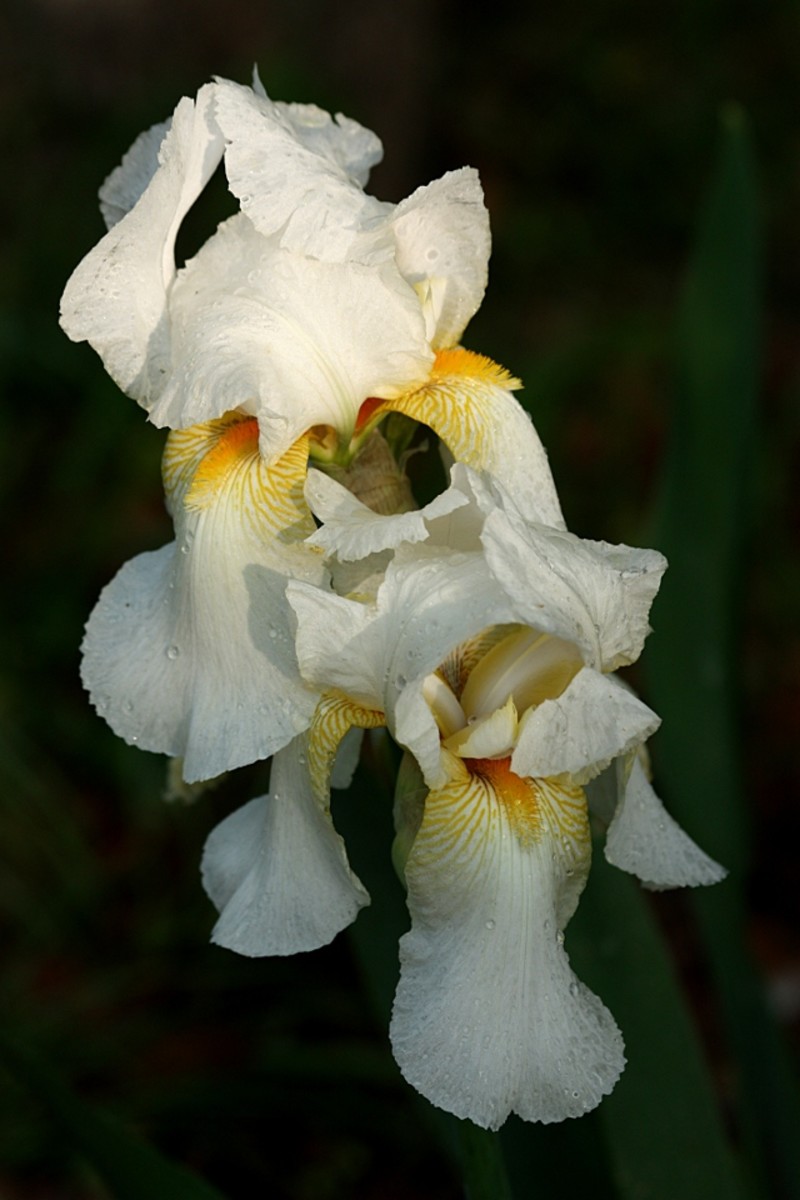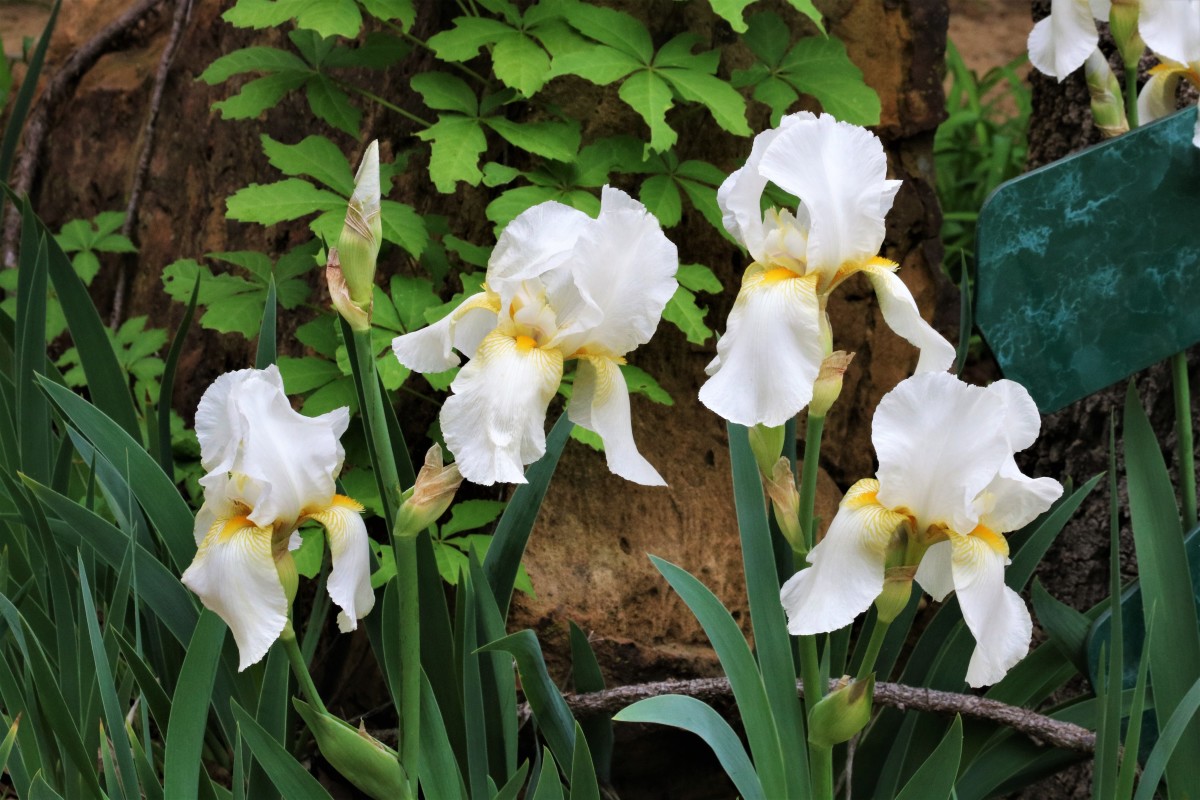- HubPages»
- Home and Garden»
- Gardening»
- Planting Flowers
A Beginner's Guide to Creating an Annual Flower Bed
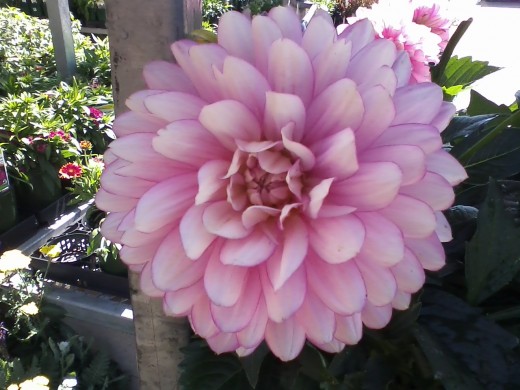
Why Plant Annuals?
There is such a wide variety of annual flowers available. It is easy to plant annuals in your garden beds, around your perennials or bushes, and in your containers or window boxes. In most cases, annuals only grow for one season, which gives you the opportunity to change your style every year! When combining annuals with established shrubs or perennials, you can embellish your landscape and have long lasting color. As opposed to most perennials, annuals continuously bloom throughout the season. Although they require some maintenance, nurturing flowers is good for the body and mind, from which even beginning gardeners can benefit. Annuals are less expensive than costly perennials and shrubs, especially when started from seed. The bright and bold blooms from annual flowers are guaranteed to attract beautiful butterflies and hummingbirds into your garden. Some of these flowers have a lovely fragrance, and can be cut for use in small vases.
Petunia
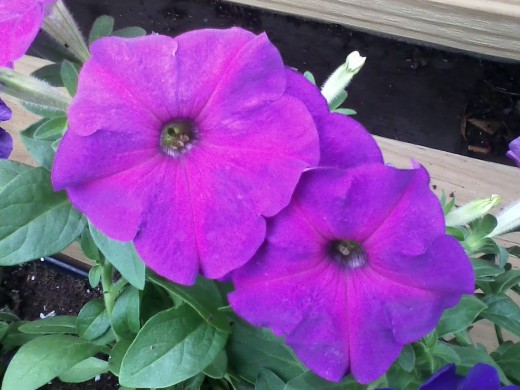
Select a Location for the Flower Bed
Choose an area to start your garden. It can be any size, but should be at least a few feet wide to allow room for the plants' roots to expand underground. Take note of how much sunlight strikes the area during the day, you will need to know this when selecting which plants you want to put in. An area with complete shade and no sun will be very difficult to work with, so make sure you have at least two hours of direct sun, or filtered sunlight during the day. Some people use borders, bricks, or a small fence to define the section for planting. If you are making a garden where there is grass or weeds growing, you must remove them, along with their roots. Choose an area that is not going to be disturbed much, out of the way of foot traffic.
Kids love gardening too!
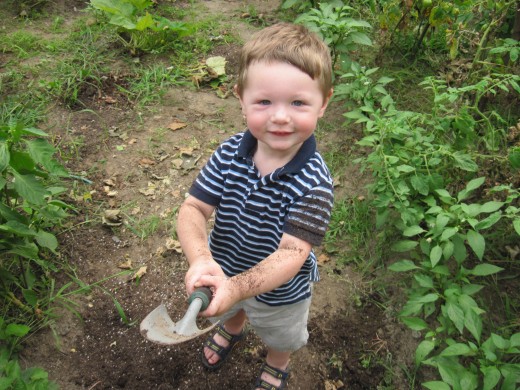
Amend the Soil
When you grab a handful of soil from your garden bed, how does it feel in your hand? If you squeeze the soil and it clumps a lot, your soil probably has too much clay in it. If the soil crumbles immediately, and looks dusty, your soil is too sandy. It is easy to fix these issues, in order to make your soil ideal for growing flowers. For clay-like soil, you'll want to add peat, wood chips, or straw to make it less dense. You will need to aerate this soil while adding these amendments, so thoroughly mix them in until the soil seems fluffier. Sandy soil poses a problem because it will not be able to hold onto moisture very well. It helps to add peat, manure, or compost until the soil looks dark and rich. It is best to amend your soil a few months prior to planting, to allow the ingredients to fully incorporate, but it wont harm anything to plant immediately after amendment. Many people avoid manure because of the smell, but rest assured, the scent of manure dissipates after a few days. Manure is a great fertilizer, and sometimes you can get it for free if you live near a dairy farm that gives it away.
Expert Tip: Save your fireplace ash. It adds nitrogen to your garden soil and also keeps away slugs and snails
Quick Poll
What is Your Favorite Annual Flower?
Plan Ahead Before You Purchase Seeds or Plants
It may save you some money to start your flowering plants from seed, early in the spring. It is helpful to have a small greenhouse (you can find a cheap one for about $20 or make your own). Take a look at the area you are planning on using, and try to estimate how many plants you will need. When you plant seedlings, you'll want to give them at least 3-4 inches in between plants. Seeds can be started in numerous ways, but a simple way is to use trays with drainage holes, and a good quality potting soil. Most garden shops sell the specially designed trays, but if you purchase packs of seedlings, save the packages for the next time you grow seeds. The trays with little holes for each seedling are best, because if you use large pots to start seeds, you run the risk of fungus or accidentally over-watering. Seed packets will clearly state on the package how long the seeds take to appear. It is good to plant your seeds at least one month before you start your garden bed. It is easy to sow seeds directly into the garden, but it will be difficult to control the outcome and it wont look as organized, so I recommend growing the seedlings first.
Be Green- Use recycled materials to start seedlings: http://www.homegrown.org/profiles/blogs/diy-making-you-own-seed
Visit Your Local Garden Center for a Wide Selection
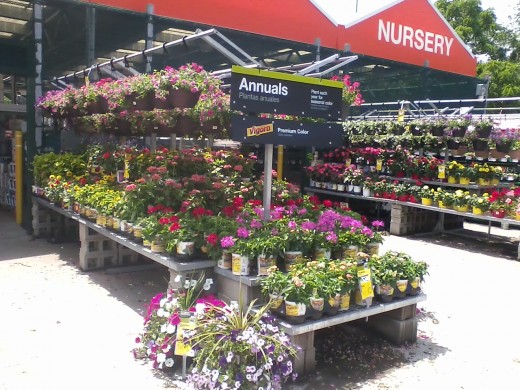
How to Select the Best Plants When Shopping at Your Local Garden Center
When you go to your local garden center, you may feel overwhelmed by the massive selection of beautiful blossoms. Bear in mind, the premium (and most expensive!) plants will be front-and-center. Do a quick tour of the entire area, so you can get an idea of the prices, and be prepared with a general idea of how much you want to spend. If you are planting in a large area, it is cost-effective to buy large trays of seedlings. However, if you want a wide variety of flowers, you may end up spending more, because the smaller packs are a bit more expensive. Individual pots of flowers will cost more than the packs, but they are generally larger plants, so you'll not be waiting as long for them to grow large. You'll need to recognize a healthy plant vs. a sickly plant. To find the healthiest plants, first try to find the area where the newest (and freshest) shipments are delivered, and shop right off of the fresh carts. On the display tables, look for plants with lush, deep green (not yellow) leaves that are not mushy or dropping. Yellowing leaves indicate that the plant has been neglected, or over watered. Be sure that the plant's soil is somewhat moist, because a plant sitting in hard, dry soil will be distressed. Experienced gardeners will search for plants that have buds, instead of plants that are fully blossomed.
When is the best time of year to plant? It is advisable to start early in the season for best results, but not too early. Most people plant in May, when the threat of a frost is gone. Some plants, like pansies, will tolerate the early spring cold, but others will become distressed if they are exposed to the cold.
Gerbera Daisy
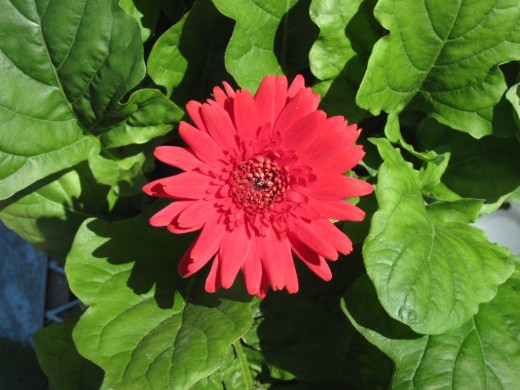
Sun, Part-Sun, or Shade- Plant Accordingly
For best results, you need to fill your garden bed with plants that enjoy the amount of sunlight that you have. When you read that a plant likes "sun," "part-sun," or "shade" it refers to the amount of time that the plant is exposed to direct sunlight. The sunlight guidelines will tell you how much direct sunlight the plant will tolerate, not how much light the plant needs. Unless your plant is a shade-lover, it will do best with at least 4 hours of sunlight, which helps the plant produce its maximum output of blossoms. A full-sun plant will flourish in 8 or more hours of direct sunlight. A part-sun plant will do best with 4-6 hours of direct sunlight. Lastly, a shade-loving plant will do best with 4 hours or less of direct sunlight. If you have a garden that is full-sun, you will most-likely have the largest variety to choose from when you go shopping at your local garden shop. Here are some examples of easy-to-grow annuals.
Full Sun Plants:
- Petunia
- Marigold
- Salvia
- Geranium
- Calibrocha
- Verbena
- Portulaca
- Sweet Potato Vine
- Lantana
- Chrysanthemum
- Celosia
- Angelonia
- Penta
Part-Sun Annuals
- Pansies
- Gerbera Daisy
- Snapdragon
- Argeratum
- Bacopa
- Plectranthus
- Lobelia
Shade-Loving Annuals
- Impatiens
- New Guinea Impatiens
- Coleus
- Torenia
- Begonia
- Fushia
Time for Planting!
Once you have your soil ready and your plants on-hand, you can begin planting in your annual garden. The plants should have a label which states how tall they will become. Most people will plant the tallest-growing plants in the back, and the shortest, or creeping flowers, in the front. This creates a tiered effect, and it will look like a cascade of blossoms! With your trowel (or a spoon if you don't have one) create a hole the is deep enough and wide enough for the little plant. Carefully remove the seedling from its container, and loosen the roots if they are twisted (this doesn't hurt the plant at all). Place the seedling in the hole so that the top of its soil is even with your garden soil level. Pat down the soil around the seedling once it is in, but don't pack it down too hard either. Most plants should state on the label how much space they need, but most of the time, you'll want to space them out by about 4 inches between plants. This gives the roots enough room to expand, and allows air-flow once the plant is fully grown. Once all of your plants are in the ground, lightly water the soil and try not to douse the actual plants with water. It is best to lay down about 1-2 inches of mulch over the soil. Take a step back, and admire your work.
How to Maintain Your Annual Flower Garden
It is best to check your garden daily to give it some tender loving care. Your first priority is to see if the soil need water. If the soil feels dry, you should lightly water your garden. If the soil feels soggy, you don't need to water at all. Try to not let your garden be constantly soggy, because this can encourage root-rot and fungus. Additionally, try to water early in the morning, if possible, because watering at mid-day means the water will reflect too much sunlight onto the leaves and blossoms, which creates spots and wilting. Watering too late in the day means your plants will remain moist throughout the night, which increases risk of fungus.
Most annuals appreciate a dead-head treatment. Dead-heading is a process which helps the plant continue to blossom, and I assure you- this is absolutely necessary to get the most blossoms! When you find a blossom that is exhausted and wilting, use your thumb and pointer finger to carefully pinch behind the blossom to remove it. Each plant is a little different in this regard, but with practice, you'll be dead-heading like a pro in no time! By pinching off the old blooms, it prevents the plant from "going to seed." By removing the blossom, you remove the seed, essentially "tricking" the plant into making more blooms. The plant's natural process is to create seeds to carry on its existence, so removing the seeds keeps the plant in a constant cycle of blooming.
In order to best protect your plants, keep an eye out for evidence of pests and insects. If you have a stubborn mole or a neighbor's cat that likes to dig in your garden, you can use red-pepper flakes or cayenne pepper sprinkled around the border of the garden to deter them. If you notice holes in the leaves, you'll want to go outside at dusk and check for japanese beetles. If you see a lot in your garden, hang a bag-trap (sold at garden centers) in your yard, but place it as far away from the flower garden as you can. other types of bugs can be deterred by using insecticidal soap, which can be made at home with natural ingredients, or, you can purchase this spray at a garden center. Deer and rabbits can be deterred by a garlic-based spray.
Learn how to make your own pest repellent spray: http://www.care2.com/greenliving/homemade-insecticidal-soap.html
Monarch Butterflies Love Annual Flowers
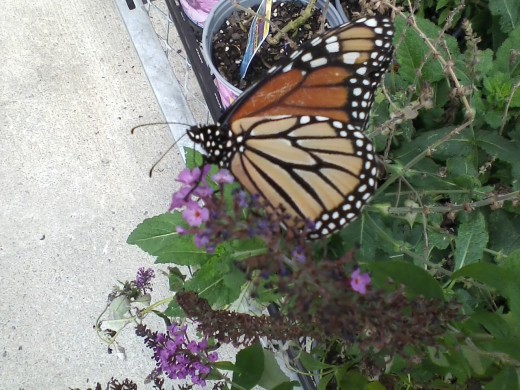
Attract Butterflies and Hummingbirds
Plants with big, bold blossoms will attract butterflies, dragonflies, and hummingbirds from afar. As they fly, they will notice your large patch of flowers, and zoom in for a closer look. The most fragrant flowers will attract butterflies, and hummingbirds love flowers that are trumpet-shaped. Bright pink, red, yellow, and orange are likely to catch their eye. Hanging a hummingbird feeder in the area will increase your chances of them visiting. To increase the odds, add a butterfly bush, trumpet vine, or honeysuckle to the area. Hummingbirds absolutely love trailing verbena and fuscia. Dragonflies love lantana and chrysanthemums. Once, these beneficial creatures discover your garden, they are bound to keep coming back for more, as they search for tasty nectar. They will benefit your garden by transferring pollen from one bloom to the next, and they deter less desirable insects as well.
End of the Summer
As the summer ends, and autumn approaches, many of your plants will begin to look tired and/or stop blooming. This is completely natural, although some types of annuals will continue to blossom into November, if you are lucky! One strategy that some people use is to replace the tired plants with fresh, fall-loving plants. Examples of plants that do well in the fall are chrysanthemums, asters, millet, fountain grass, and pansies. Toward the end of the planting season is the ideal time to plant bulbs for spring. In late summer and fall, you will find the best selections of bulbs on store shelves. These include: daffodils, tulips, hyacinth, paper whites, crocus, and lilies. Before the frost, remove any dead plant material from your garden bed, to make things easier for yourself, and rake any leaves away from the area.
Gardening takes practice, and is often a process of trial and error. We can always learn from our mistakes. Along the way, you can search for resources to find helpful information to guide you. There are television shows about gardening, as well as books, magazines, websites, and blogs with a wealth of knowledge from experienced gardeners. Don't forget, youR local nursery or garden shop's staff members will usually be able to answer your questions. Most of all, enjoy yourself! Gardening is considered to be therapeutic, and we can all benefit from getting outside into the sunshine! It is also good exercise, and a way to express yourself. Your flower bed will enhance your home's curb-appeal, and beautify your neighborhood.


